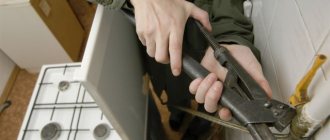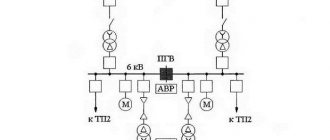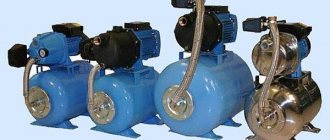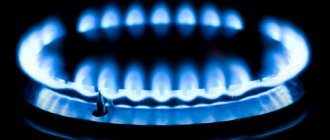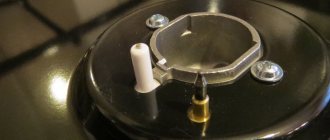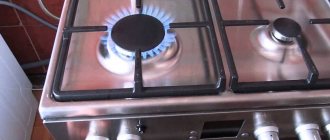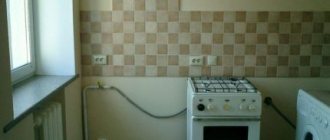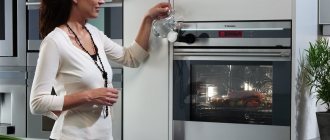The modern household appliances market provides potential buyers with a wide range of gas stoves. One of the popular purchasing options are combined-type models, where, along with a gas resource, an electric one is also used. However, for buyers of such equipment, connecting a gas stove with an electric oven often raises questions. Do you agree?
Indeed, if you study the rules for handling gas and electricity, you can see that they clearly separate the marked resources. Accordingly, the practice of connecting hybrid gas stoves has some peculiarities. Let's consider these issues in more detail, paying attention to installation standards and rules for connecting to electricity and gas supply systems.
What kind of plug does the combination stove have?
The “cooker” and/or oven with a power of up to 3.5 kW is connected to a standard 16 A/220 V outlet. In most cases, the oven has a regular wire and a 16-amp plug
(if connected independently), so only
a socket
.
Interesting materials:
How to format a Meiza phone? How to speak in a different voice on the phone? How to play games from your phone on your computer? How to use a mobile phone as a modem? How to connect a phone to a zte router? How to put money on your phone through an ATM? How to glue a touchscreen to a phone? How to feed a horse in Minecraft on your phone? How to change IP on your phone? How can I connect my phone to my computer?
Features and conditions of the connection process
The first and one of the most important conditions is the ability of the wiring to withstand significant loads.
The house or apartment must have copper wiring with a cross-section of at least 4 mm. sq. If the power of the stove is significant, then a wire of 6 mm is required. sq. section.
The best option would be to lay a separate line for connection; this will allow you not to load the general wiring of the house, especially if it is an old building and the wiring is not designed for significant loads.
The second condition is the ability of the automatic switchboard to work with significant loads.
Therefore, the wiring that will power the stove should be connected to the circuit breaker with the highest current value, or an additional powerful circuit breaker should be installed under it in the distribution panel.
In this case, the current value of the machine should be one rating higher than this parameter of the plate in order to avoid critical loads. That is, when connecting a device with a current consumption of 20 A, a 25 A machine is used.
The third condition is the availability of additional means of protection. They can be differential circuit breakers or a residual current device.
The last condition is the correct connection. The stove can be connected to an outlet, which provides some convenience, allowing you to turn it off at any time.
But the socket and plug must be powerful and capable of operating under loads.
Choosing the power of a new hob
For any cooking equipment, power is considered the main indicator. This criterion determines how long the food will take to cook on the stove and how convenient it will be for the housewife to work with the electric surface. It’s good when the burner heats up in just a couple of seconds and cools down just as quickly. But this convenience also has a disadvantage - high energy consumption.
Electric
A hob for connection with 4 burners is in demand. Manufacturers have equipped the device with heating points of different power:
- 1 conf. − 0.4-1 kW.
- 2nd conf. – 1.5 kW.
- 4 conf. – up to 3 kW.
The total is 7 kW.
| Advice! There are units on the market with additional options, such as adjusting the overall heating level for each point, with a large number of points, for non-standard shaped dishes, etc. the total power can increase to 10 kW. |
Induction
This is the most modern type of equipment for heating food in the kitchen. The average power of such a surface is 7 kW. But we are talking about the consolidated power of technology.
Gas
Natural fuel is not electricity, so it is impossible to measure the amount of energy consumed or received. You can take into account the amount of gas passing through the electric meter. The calorific value of gas is 8-11 W per hour/m3. The quality of fuel in the kitchen can be assessed subjectively.
But you can rely on the following indicators:
- Approximately capacity 1 conf. is 2-2.5 kW.
- At 4 conf. indicator 8-10 kW.
Reduced power of individual conf. compensated by the heat output of the largest burner. The higher the diameter of the burner, the greater the power.
Connection to a single-phase network
In the electric stove, under the protective cover, there are contacts to which the wire is connected.
For a single-phase network, this cable must be three-core.
One core is phase, the second is zero, the third is grounding. In the cable, each core has its own color. It is important to remember that the neutral wire is always blue or light blue, and the ground wire is yellow-green.
In the plate, there are usually more contacts for connection, but each of them has its own designation.
All terminals marked with the letter “L” are phase, no matter how many there are, zero is marked with the letter “N”, there may also be several of them, grounding is indicated with the letters “PE”, usually this is one terminal.
Knowing this, you can easily connect the cable. If, for example, there are several “L” terminals, and there is only one phase in a single-phase network, then you need to use the jumpers that come with the stove.
First, we connect the ground wire to the “PE” terminal, then the zero wire to the “N” terminal.
If there are several such pins, we use a jumper, connecting them together, and then connect the blue wire to one of the pins.
The last phase is connected. We connect all the pins marked with the letter “L” with a jumper (if there are three of them, then they are designated as “L1” “L2” “L3”).
After connection, connect the phase wire. In a three-core cable, it may be brown, gray or black.
A few words about grounding
Now about grounding. Since the power of the device is high, grounding is necessary. One of the options for connecting an electric stove to grounding is to use the general grounding of the house, if available.
To do this, it is better to contact the housing office and ask whether your distribution panel is connected to the grounding of the house.
If the answer is yes, all that remains is to connect the ground wire to the grounding of the panel.
It is not difficult to identify - it is usually a thick wire. Connected to the shield body using a bolted connection. The ground wire is connected to this connection.
If there is no grounding in the house, but you live on the ground floor or in a private house, then you can do the grounding yourself.
In short, three rods are driven into the ground near the apartment and connected to each other with metal tape.
A steel wire is attached to this tape and laid to the apartment. And the grounding wire is connected to this wire.
You can find out more about making grounding for your home here.
Self-connection of an electric stove is described in general terms. In the process, many nuances can arise. For example, it was decided to connect the stove to the general network of the house, but it turned out that it is aluminum and is not counted for such loads.
Or the circuit breakers in the distribution panel are weak. Alternatively, there is no grounding in the apartment and it is not yet possible to install it. All this needs to be taken into account, but with the right approach, these problems can be solved.
ARTICLE RATING:
ratings, average:
out of 5)
I haven’t done electrical work for a long time, but now I had to. My mother-in-law didn’t have the money for a proper electrician.
The switchboard is in the apartment, a two-wire cable connects to the meter from the entrance. Inside the apartment I changed the wiring and assembled the panel according to the diagram (without the green wire):
Now the question arises: how to connect an electric stove in the absence of grounding? Is it possible to wire the zero as shown in the picture with a green wire? In other words, is it possible to have the correct scheme:
change it to this:
I would like to hear a reasoned answer, i.e. what is the risk of such a rework. Or maybe it’s grounding, there’s an RCD and that’s okay.
PS. I love my mother-in-law, I don’t wish her harm.
Why doesn't the electric ignition work and what should I do?
Electric ignition device diagram.
Even if this mechanism is assembled perfectly, it can still break someday.
Electric ignition may not work due to:
- Spark plug contamination. This malfunction can be easily fixed without leaving home and without resorting to the help of a specialist. To do this, you need to remove the fat deposits that have accumulated on the candle using a cotton swab dipped in alcohol.
- Power surges that occur on a regular basis.
- Incorrect handling of equipment. For example, you tried to ignite gas when the flame breaker was removed.
Separately, it should be said that in the first and second cases described above, you need to seek the help of a specialist.
Connection without socket
Connecting a stove without using an outlet, but using a terminal block, is practically no different.
The wire is connected to the machine, then it cuts into the RCD circuit, and the wire is pulled to the installation site of the stove.
A recess is made in the wall into which a protective box is installed. The terminal block is placed in this box.
The wire coming from the distribution panel, as well as the cable from the stove, is supplied and connected to it.
They are fixed in the terminal block; it is important not to confuse which wire is which.
After this, the protective box is closed with a lid. Well, then – a performance check.
It is noteworthy that the connection diagram for electric stoves is almost the same.
Many people are familiar with Hansa and Mechta electric stoves. Buyers often ask how to connect them correctly.
Since there are many models of stoves, it is difficult to guess which one you purchased. But we described all possible connection methods above.
See the power consumption and what wiring your model is designed for (single-phase, two-phase or three-phase) and apply our recommendations.
The Hansa stove from a foreign manufacturer is connected to the network, just like the domestic Mechta stove. It is only important to choose the right wiring and all other elements included in the power line.
Popular among readers: Methods for replacing electrics in an apartment.
Skewer
When using a spit, you need to be extremely careful. Its rod and forks have sharp ends, so there is a risk of injury. It is necessary to insert the holder hook into the hole located in the upper part of the cabinet. Place the first fork on the spit, then thread the meat onto it and insert the second fork. Then you should tighten the plugs using the screws. Place the front part of the spit on the hook of the holder and remove the handle. Place a baking sheet on the very bottom and turn the mode control knob. It should be borne in mind that you can cook products on a spit with a weight not exceeding 5 kg.
Electric burners
The two above protective devices can be replaced with one - a differential circuit breaker. Diagram and connection methods Electric household stoves are powerful equipment, the current they consume is on the order of A. They are usually located in a separate “pocket”, in the same place as the terminals.
Often these problems become insurmountable. To perform this operation you will need a long ruler, a square and a pencil.
Further, according to paragraph. Cambric is best suited for this purpose.
The oven also has its own lamp, which is indicated by the number 5.
After which the ends are pressed in with press pliers and insulated with electrical tape or thermal tube. So before turning it on, be sure to double-check that the phase and neutral wires are screwed in correctly.
Also available HL3. The fixing bar holding the cable is also removed. Naturally, the circuit through which the current passes changes. Replacing a burner on an electric stove is easy and simple...
Complete connection diagram via socket
Now let’s look at the complete connection diagram for an electric stove; for example, let’s take a model operating from a 220 V network (single-phase), and we’ll lay a separate line for it.
First, let's connect it using a socket. Before starting work, the switchboard must be de-energized.
So, first of all, we connect the wire to the machine on the distribution panel.
We connect the phase and neutral wires to it, the ground should be connected to the grounding of the house or apartment.
Regarding grounding - a little lower. Immediately behind the machine we connect the RCD in series and secure it.
Then the wire is pulled to the location where the socket is installed. This can be done in an open way (using a corrugated tube or plastic box).
Read more here: How to properly install electrical wiring.
The socket and plug for a single-phase network must be three-pin.
When connecting wires to an outlet, be careful not to tangle the wires. The earth must be connected to the ground contact, the zero to the zero contact, and the phase to the phase contact.
And you definitely need to make sure that the cable from the stove is connected to the plug in the appropriate way. It is very important not to confuse the wiring.
We fix the socket on the wall, it is important that it is located at a distance from metal structures (pipes or radiators), that it is not affected by heat sources, and that water does not enter.
Then we connect the power cable along with the plug to the stove. After this, we carefully check all connections, they must be well tightened, all elements of the circuit must be securely fastened.
Next, a trial run is carried out. First, the machine turns on, then the RCD, and the stove itself.
After turning on the stove at full power, everything is turned off and all elements are checked for heating.
The most preferred type of oven
Which oven to choose depends only on your preferences.
What you should pay attention to when choosing:
- Gas ovens are more economical to use, but not as safe. When gas burns, many harmful substances will be released into the air, and if used intensively without proper ventilation of the room, this can affect the health of family members.
- Electric ovens will consume a lot of electricity, but will delight you with functionality. Here you can choose the modes of upper or lower heating, convection, grill, and reheating. And flexible temperature settings will allow you to cook even “capricious” sponge cakes.
Connection to a three-phase network
To connect a stove operating from a three-phase network, you need a cable with 5 cores, 3 of which will be phases, the other two - ground and zero.
Again, first connect the ground and zero, having previously shorted the zero terminals with a jumper, if there are several of them.
We connect one phase wire to the three phase terminals.
The colors of the phase wires may be different, but it is important to remember that the neutral wire is always blue or light blue, and the ground wire is yellow-green.
Keeping this in mind, you can easily connect the cable to the stove, and it does not matter what network it is on.
Security measures
When connecting, it is important to take security measures seriously. The wiring, socket with plug or terminal block must be designed to withstand significant loads.
The most important thing is to choose the right cable cross-section.
All connections must be well tightened; loose loose bolts or screws when connecting wiring are not allowed.
It is also important not to confuse the wiring when connecting to the stove, socket, RCD plug and machine.
Let's summarize.
In order for the electric stove to operate with maximum safety, it is necessary to ensure the supply of electricity to it with the appropriate parameters - the wiring, socket and circuit breaker must withstand a load greater than that created by the electric stove, but the RCD in terms of current strength must be as close as possible to this parameter of the electrical appliance. And it’s better if a separate line and automatic machine are used to power the electric stove.
But compliance with the conditions is not enough; you still need to connect the wiring correctly. After all, stoves can operate from a single-phase or three-phase network; there are also two-phase stoves, and it is important to connect everything correctly.
How to connect a gas stove in country conditions
Often cases of independent connection of gas stoves are found in dachas and country houses. But even in such conditions, any gas equipment should be installed only by professionals. Building codes and regulations have a whole list of requirements for the premises where gas appliances will be installed.
When independently connecting a gas stove to a cylinder, you must comply with the following requirements:
- The plate must be placed no further than two meters from the cylinder
- The capacity of the gas cylinder should not exceed fifty liters
- Connecting the tiles to the cylinder requires a project, which is also developed by special organizations
- A nozzle with a smaller diameter should be installed on a gas stove so as not to stain the dishes and ceiling
Methods for diagnosing connected equipment for leaks
The initial check, as already mentioned, is carried out by the master. After this, specialists will once again check not only each connection, but also the taps of the new gas stove. This action is performed using a special device called a gas analyzer. Such a device detects the slightest leak, which cannot be detected even with foam, and signals this to the inspector.
A gas analyzer is a very convenient electronic device for detecting leaks PHOTO: kimo-russia.ru
When checking the stove for commissioning, a gas service specialist opens the top cover of the unit so that you can get to the nozzles, taps and tubes connecting them. The connections between them are checked for leaks. There is no point in doing this work for the owner himself. All connections here are stationary, which means that one check every six months (this is the required interval) is quite enough.
For a complete inspection, the top cover of the slab is removed PHOTO: ibuy.com.ua
Is it possible to connect an electric stove via an extension cord? Is it dangerous?
There is no way to move the outlet closer, is it possible to connect the electric stove via an extension cord, is this not dangerous?
comment to favorites Elden [87.1K] over a year ago
In general, I would advise not to use an extension cord, but to replace the electrical cable on the stove itself with a longer one; this is quite simple to do if you understand at least a little about electricity, especially since you just need to disconnect 4 wires from the stove side and 4 wires from the plug side (if A 3-phase connection has 5 wires) for 380 volts, or 3+3 wires for 220 volts.
Here are approximate connection diagrams, of course everything is individual, but I’m showing pictures for your reference:
The costs should be even less, since you only have to buy the wire.
But I don’t rule out connecting via an extension cord, this can be done, it’s even safe, if you install an extension cord, namely its socket, on the wall, in some cases this is possible, or you purchase a mother-to-male connection specifically for portable extension cords, then there are safety problems will not be.
The only negative that I see in terms of long-term operation is the appearance of another quick connection in the circuit, which will oxidize over time and the contact will be weaker, and accordingly the plug and socket will begin to heat up. But if you purchase high-quality components, it will last for a long time.
moderator selected this answer as the best comment add to favorites link thank Kim Jong-un [412K] 2 years ago
I would like to note right away that if possible, it is better to avoid connecting any household appliances through an extension cord, especially such powerful ones as electric stoves.
Electric stoves are different (there are 1 kW, there are 8 kW and even more), some of them are supplied with power sockets and a separate line.
Of course, it is better not to connect such electric stoves through an extension cord, and it is extremely difficult to find such an extension cord with large cross-section wires and a power outlet.
Most likely you will have to make an extension cord yourself, buying a plug, power socket, cable, which can further aggravate the situation.
But of course, connect the electric stove via an extension cord; this is the easiest connection option if the outlet is far away.
But this method has a number of disadvantages, and many of them are critical:
For some models of electric stoves, it is almost impossible to find an extension cord on sale (there are none).
In the circuit (the circuit that powers the electric stove), unnecessary additional connections appear, which can heat up, which ultimately can even lead to a fire.
The power cable of the extension cord can be damaged mechanically, the extension cord does not fit into grooves, it just lies on the floor, passes through furniture, it can be damaged by children, animals, or the extension cord will simply fray, which is extremely dangerous.
Damage to the insulation on an extension cord may result in electric shock.
If we are talking about powerful electric stoves, then it is strictly forbidden to connect it via an extension cord.
Connection to a two-phase network
A rare, but still common connection method.
The connection diagram for an electric stove operating from a two-phase network is somewhat different, since this requires a cable with 4 cores, two of which will be phases, the other two will be zero and ground.
The connection is made as follows: connect the ground wire, then use a jumper for the zero terminals and connect the neutral wire.
If the plate has three phase terminals, then connect two of them with a jumper and connect one phase wire to one of the terminals, and the second phase wire to the remaining third terminal.

